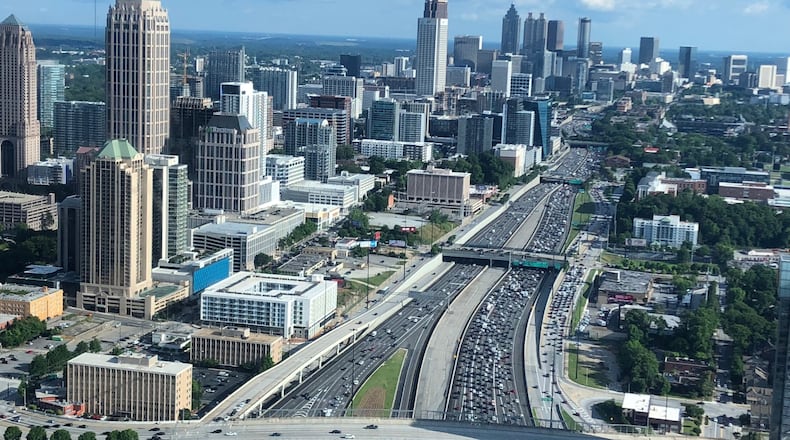The long-sought vision of an elevated park capping the Downtown Connector in Atlanta advanced this week with the City Council’s creation of a special tax district to help pay for the massive redevelopment project.
A 14-acre green space will cover three-quarters of a mile of the Connector between Ted Turner Drive and Piedmont Avenue.
The plan for the Stitch, as the project is known, is to reconnect downtown neighborhoods that were divided when the highways were built, slicing up the city in the 1950s and ’60s. Several historically Black neighborhoods were demolished and displaced in the process.
“The great thing about this project is it’s attempting to reverse — or at the very least repair — some of the damage, some of the poor decision-making that was made by previous generations of Atlantans, previous generations of Georgians, and the federal administration that worked to destroy and displace historic communities,” District 4 Council member Jason Dozier said Thursday.
A significant portion of the project will be in the new District 4 borders that take effect next year.
The first phase of the Stitch would cap the section of the Downtown Connector between Peachtree and Courtland streets, and include a pedestrian plaza and garden of native plants. About $200 million, mostly in federal grants, has been secured to pay for that part of the project.
Construction for the first phase is scheduled to start in late 2026, and could last until 2030.
The full project is slated for completion by 2036, contingent upon funding.
On Monday, the City Council approved three ordinances that create the special tax district and call for the setup of a nonprofit entity to operate and maintain the park, which will require specialized maintenance because it will be located on top of an interstate.
“It was an important milestone in our progress,” said Jennifer Ball, chief operating officer for Central Atlanta Progress, which has released a 400-page master plan on the project. “They set up a governance mechanism as well as a sustainable funding stream for the operations and maintenance of the park that we are going to build.”
Ball added that the City Council’s action allows the Atlanta Downtown Improvement District to legally enter into contracts and other agreements to move the project forward.
Ball said she’s not too concerned about how the project could be affected by the barrage of federal policy changes and uncertainty around funding that is coming out of President Donald Trump’s White House.
“There’s always risk with any grant, particularly in the environment that we’re in today,” Ball said. “We’re doing everything we can to comply with our executed grant agreements. The funds are obligated to our active phases.
“We are receiving reimbursements, so our goal is to keep on keeping on, meeting our end of the bargain, exploring the benefits of the project — how critical it is to the infrastructure of this part of the city.”
Commercial and multifamily property owners in the special district would pay an additional tax to fund the Stitch’s operations and maintenance. Ball said owner-occupied residents would not be subject to the additional tax, which will be at the rate of $2 on every $1,000 of assessed property value.
When the park covering is complete, businesses that once backed up to the highway will have a front door to the park.
Jack Cebe, who is overseeing the project, has said that the master plan has recommendations to redesign those properties. The plan calls for retail and restaurants along the park, but the final designs will be up to the individual property owners.
The master plan also includes a recommendation that 30% of new and existing housing within a half-mile of the Stitch qualify as affordable.
“We’re creating the conditions for housing to return to this area,” Dozier said. “Doing projects like this, making sure we continue to invest in projects like this, sends a signal that we are making sure that Atlanta continues to stand the test of time.”
About the Author
Keep Reading
The Latest
Featured



